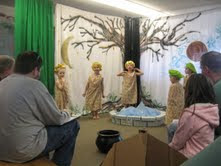 From Education Week
From Education Week
Comment: I think this article is a good one based on what we see so early in the children we serve. I think the management of the classroom has a lot to do with why boys are less likely to enjoy school. Studies in a boys life are one of many interests, and the physical is often neglected. More recess is the answer. Boys will do better with more time to move.
Boys Trail Girls in Reading Across States
A new study on gender differences in academic achievement, offering what it calls “good news for girls and bad news for boys,” finds that, overall, male students in every state where data were available lag behind females in reading, based on an analysis of recent state test results. At the same time, in mathematics, a subject in which girls have historically trailed, the percentages of both genders scoring “proficient” or higher were roughly the same, with boys edging out girls slightly in some states and girls posting somewhat stronger scores in others.
In certain states, such as Arkansas, Hawaii, New Mexico, and Vermont, the gender gap for reading proficiency was 10 percentage points or higher, based on 2008 test data.
“The most pressing issue related to gender gaps is the lagging performance of boys in reading,” says the report, released today by the Center on Education Policy, a Washington-based research and advocacy group.
In a conference call with reporters, Jack Jennings, the group’s president and chief executive officer, noted that whether looking at student outcomes at the elementary, middle, or high school level, male rates of proficiency were lower than for females across all states studied in 2008. (Forty-five states had data available for all three levels.)
“There is a consistent achievement gap,” he said. “Something is going on in our schools holding back boys.”
The report does offer some encouragement for boys in reading, suggesting that as a group, they are making some gains over time, and that the gender gap has narrowed in many states.
For instance, in 38 out of 44 states, the percentages of 4th grade boys scoring proficient or higher climbed between 2002 and 2008. Also, in 24 out of 44 states, the gender gap for 4th graders in the percentage of students scoring proficient or higher narrowed over that time period, though it widened in another 14 states.
When looking at the data another way, however, based on changes in the average of test scores, the gaps between boys and girls in reading “widened across all three grade levels [elementary, middle, and high school] as often as they narrowed.”
‘Clear and Startling’ Differences
The new report from the Center on Education Policy is part of a series of studies the organization has been conducting that examine trends on state tests since 2002, when the federal No Child Left Behind Act was signed into law by President George W. Bush.
The center notes that one reason for the report’s focus on the rate of students deemed “proficient” is that the designation is the key indicator used to determine whether districts and schools have made adequate yearly progress under the federal law. However, as the report emphasizes, each state uses its own tests to gauge proficiency and also sets its own cutoff score for what it judges proficient.
The report says that research has long noted historical differences in the achievement of boys and girls in reading and math, though considerable recent research suggests there is no longer a gender gap in math achievement.
With its state-by-state analysis, the report is able to identify those states that appear to struggle the most with gender gaps in reading. In Arkansas, the gap was 13 percentage points at the elementary level and 14 percentage points at both middle and high school in 2008. On state tests in Hawaii that year, boys came in 14 percentage points behind at the elementary level, 13 in middle school, and 16 in high school.
In the conference call, Mr. Jennings noted that even Massachusetts, a state known for its strong academic standards and performance, has a sizable gender gap, at 13 percentage points for elementary students in 2008.
Some other states, however, such as Florida, Kansas, Nebraska, and Virginia, had much smaller reading gaps at all levels. In Virginia, for example, the gender gap for boys was 3 percentage points at the elementary and middle levels and just 1 percentage point in high school.
In most cases, the gender gap in state math achievement did not exceed 5 percentage points, the 2008 data show.
Susan B. Neuman, an education professor at the University of Michigan who specializes in literacy development, called the new study “an extraordinarily important document.”
Ms. Neuman, a former U.S. assistant education secretary under President Bush who was invited to participate in the conference call but was not involved in the study, emphasized the findings with regard to boys’ achievement, noting that it is a relatively recent trend.
“We’ve been talking about closing the achievement gap in so many different ways, … but we have not focused on the gender gap, which is very clear and startling in this report.”
She added, “I think we have to re-evaluate our curricula, re-evaluate how we are managing our classrooms.”














